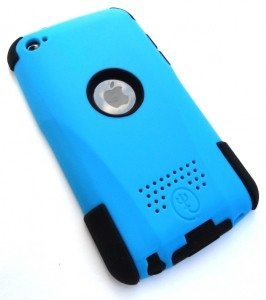 Being the case hound that I am, I’ve scoured the web and found zillions of cases, but I’d never heard of Trident Case. My first thought was that, although the basic design appears similar to many other cases out there, their cases have a subtly cool style and some interestingly executed features. I asked my 8-year-old son if he’d like to help me try out a new Aegis case for his iPod touch 4th gen. He agreed we were off and running!
Being the case hound that I am, I’ve scoured the web and found zillions of cases, but I’d never heard of Trident Case. My first thought was that, although the basic design appears similar to many other cases out there, their cases have a subtly cool style and some interestingly executed features. I asked my 8-year-old son if he’d like to help me try out a new Aegis case for his iPod touch 4th gen. He agreed we were off and running!
NOTE: All images in this review have been enabled with clickable enlargeability for your viewing pleasure. 😉
Background
If nothing else, Trident Case has something interesting going on with the names of their cases. Kraken. Cyclops. Electra. Perseus. Sensing a theme here? All names of characters, creatures and from mythological tales, mostly of the Greek tradition. Perhaps the most appropriate of all for the name of a gadget case is the Aegis, which in Greek mythology was the shield of Zeus, but in modern times has some to be associated with a shield or armor in general. And as you’ll see, it does its namesake proud, in my opinion. With the aid of my son (who served dual roles of both aesthetic evaluator and stress tester), we tried out the Aegis for his iPod touch 4th gen in blue color. Also available in ballistic green, red, yellow, black and pink.
Shipping Container
The Aegis arrived from Trident Case in a rather interesting shipping box, with Trident Case logos printed on the outside of it. I dig trident shape integrated into their company logos—pretty cool design!  Packaging
Packaging
The Aegis’ actual store packaging is decent enough. Opening the front flap reveals two things: to the left, on the inside of the flap, a diagram of the contents of package and on the right a window that displays the Aegis case itself (though you can’t see much of it from this view). The flap itself contains the screen protector and applicator card. 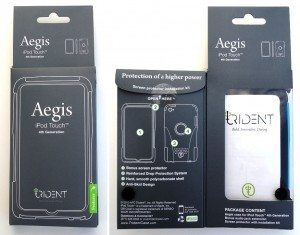 The display window on the rear of the package reveals the back of the Aegis.
The display window on the rear of the package reveals the back of the Aegis. 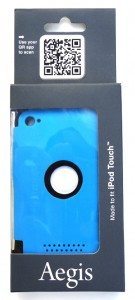 Package Contents
Package Contents
Inside the package are the following items:
- Aegis case – two parts: inner silicone skin and outer plastic shell
- Screen protector (not pictured here; I’d already applied it to the iPod touch)
- Application card
- Microfiber cleaning cloth
- Audio jack extender
- Instruction booklet
Like many cases that are out there, the Aegis case is a “hybrid” style that consists of two parts: a soft inner silicone skin and a hard polycarbonate plastic outer shell. (Well, three layers I suppose, if you count the screen protector, which I had already applied at this point). The silicone skin is designed to fit snugly around and directly in contact with the iPod touch. It includes several portals through which device features can be accessed. The plastic shell is designed to also fit snugly over the silicone skin, and has similar portals through which either the skin protrudes or device features can be accessed. 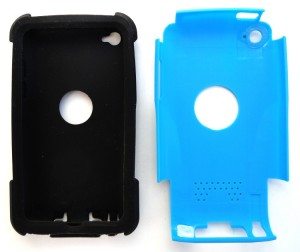 The main feature on the back of the skin is a circular cutout that exposes the Apple logo on the back of the iPod touch. Is it a vanity feature catering to Apple fanboys and fangirls? Perhaps. However, we Apple owners do like to show off our devices and their familiar logos a bit. One aspect I noted was that this cutout does not include an sort of transparent protective layer—the back of the iPod touch is exposed here, although recessed several millimeters down and surrounded by a ring of slightly thicker silicone, thereby affording some protection. There is also a keyhole-shaped cutout at the top of the skin for the rear camera. The shell has cutouts for the logo and camera and near he bottom are several rows of small holes that act as ventilation for the iPod touch.
The main feature on the back of the skin is a circular cutout that exposes the Apple logo on the back of the iPod touch. Is it a vanity feature catering to Apple fanboys and fangirls? Perhaps. However, we Apple owners do like to show off our devices and their familiar logos a bit. One aspect I noted was that this cutout does not include an sort of transparent protective layer—the back of the iPod touch is exposed here, although recessed several millimeters down and surrounded by a ring of slightly thicker silicone, thereby affording some protection. There is also a keyhole-shaped cutout at the top of the skin for the rear camera. The shell has cutouts for the logo and camera and near he bottom are several rows of small holes that act as ventilation for the iPod touch. 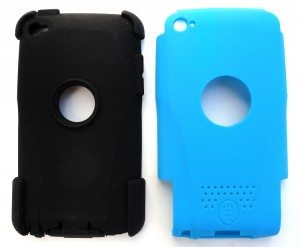 The Aegis is fairly easy to install. Here’s an instructional video from Trident Cases. The iPod touch slides easily into the silicone skin. Just slip it into the bottom, work the edges up over the sides and then slip the top down into the skin. The skin is pliable enough to flex around the iPod touch easily, but is stiff enough to stay on securely. Note that the skin has a slight relief cutout that allows full access to the home button, which is a nice touch.
The Aegis is fairly easy to install. Here’s an instructional video from Trident Cases. The iPod touch slides easily into the silicone skin. Just slip it into the bottom, work the edges up over the sides and then slip the top down into the skin. The skin is pliable enough to flex around the iPod touch easily, but is stiff enough to stay on securely. Note that the skin has a slight relief cutout that allows full access to the home button, which is a nice touch. 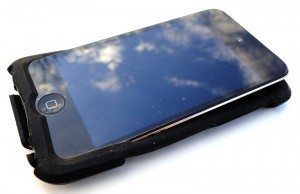 The thickness of the silicone “lip” does not detract much from using the touchscreen. With the iPod touch completely encased in the skin:
The thickness of the silicone “lip” does not detract much from using the touchscreen. With the iPod touch completely encased in the skin:  Looking at the skin from the back:
Looking at the skin from the back: 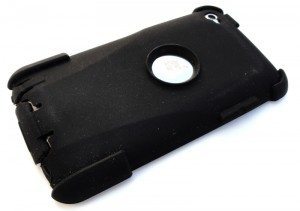 The plastic outer shell slides over the inner skin easily as well. Again, just slide the bottom of the now silicone skin-clad iPod touch down into the bottom of the shell, work the sides of the shell around the skin, then the top of the shell over the skin. I like this setup. Although other cases typically go the opposite route, it seems intuitive to me to put the hard shell on the outside as the first layer of defense and the soft skin on the inside. With the shell outside, it allows easier slide in/out of pants pocket, purse, etc. With skin inside, it both dissipates bumps and preserves the iPod touch’s easily-scratched finish on the back.
The plastic outer shell slides over the inner skin easily as well. Again, just slide the bottom of the now silicone skin-clad iPod touch down into the bottom of the shell, work the sides of the shell around the skin, then the top of the shell over the skin. I like this setup. Although other cases typically go the opposite route, it seems intuitive to me to put the hard shell on the outside as the first layer of defense and the soft skin on the inside. With the shell outside, it allows easier slide in/out of pants pocket, purse, etc. With skin inside, it both dissipates bumps and preserves the iPod touch’s easily-scratched finish on the back.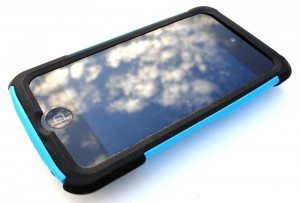 It takes a big of tugging and poking here and there to align the skin and shell, particularly around the volume buttons and the access ports along the bottom, and, as cliche as it sounds—viola! That’s it. You’re good to go. In this view, the contours along the sides and back of the plastic shell can be seen.
It takes a big of tugging and poking here and there to align the skin and shell, particularly around the volume buttons and the access ports along the bottom, and, as cliche as it sounds—viola! That’s it. You’re good to go. In this view, the contours along the sides and back of the plastic shell can be seen. 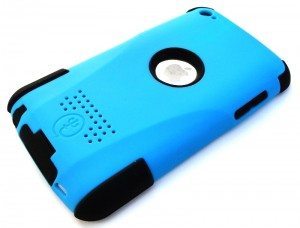 The four corners of the Aegis feature raised areas of slightly thicker silicon which as shock-absorbing bumpers. These have bee integrated into the overall design well. They are just thick enough to give a bit of added corner bump protection, but not too thick such that they are obtrusive.
The four corners of the Aegis feature raised areas of slightly thicker silicon which as shock-absorbing bumpers. These have bee integrated into the overall design well. They are just thick enough to give a bit of added corner bump protection, but not too thick such that they are obtrusive. 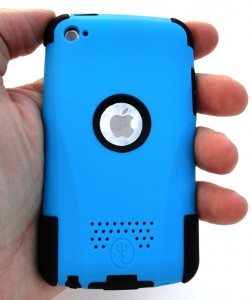 As mentioned above, the silicone is also raised slightly above the face. It is far enough to provide some edge protection without adding excessive thickness. It also provides the classic “lay on the table” design that allows you to lay the iPod touch on a table face down and not scratch the display’s face. The Aegis just feels good in the hand. Nice and sold around the iPod touch and all materials have a surface finish that are just matte enough to prevent from being too slippery, yet smooth enough to have a nice tactile feel. The shell in particular has a nice satin feel.
As mentioned above, the silicone is also raised slightly above the face. It is far enough to provide some edge protection without adding excessive thickness. It also provides the classic “lay on the table” design that allows you to lay the iPod touch on a table face down and not scratch the display’s face. The Aegis just feels good in the hand. Nice and sold around the iPod touch and all materials have a surface finish that are just matte enough to prevent from being too slippery, yet smooth enough to have a nice tactile feel. The shell in particular has a nice satin feel.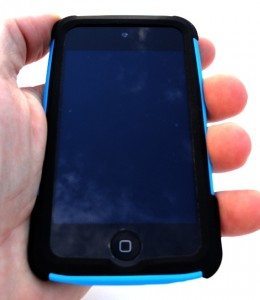 As mentioned above, the bottom of the Aegis has three main features. In the center is a protective silicone flap, integrated into the inner skin, that fits snugly into the iPod touch’s dock connector port. Next is another integrated silicone flap that fits into the headphone jack. These flaps fit very snug into their respective ports and will not come out unless you purposely remove them, which is as intended. Last is a small open speaker portal lined on the inside with a type of fiber mesh to afford some level of protection but still allow sound to freely pass through.
As mentioned above, the bottom of the Aegis has three main features. In the center is a protective silicone flap, integrated into the inner skin, that fits snugly into the iPod touch’s dock connector port. Next is another integrated silicone flap that fits into the headphone jack. These flaps fit very snug into their respective ports and will not come out unless you purposely remove them, which is as intended. Last is a small open speaker portal lined on the inside with a type of fiber mesh to afford some level of protection but still allow sound to freely pass through.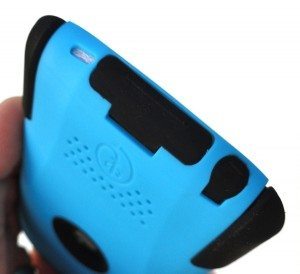 Below, two images showing both the dock connector flap and headphone jack flap in their open positions.
Below, two images showing both the dock connector flap and headphone jack flap in their open positions.  Detailed shot showing the protective flaps peeled back a bit farther. One of the few potentially weak points with the Aegis were these flaps. I actually do like having them there, as they provide just that must more protection from the elements (dust, liquids, etc). However, they just seemed like if you flexed them too far back or got them caught on something, that silicone would simply shear off. I’ve had this happen on other silicone cased I’ve owned, and it seems like it could happen here also.
Detailed shot showing the protective flaps peeled back a bit farther. One of the few potentially weak points with the Aegis were these flaps. I actually do like having them there, as they provide just that must more protection from the elements (dust, liquids, etc). However, they just seemed like if you flexed them too far back or got them caught on something, that silicone would simply shear off. I’ve had this happen on other silicone cased I’ve owned, and it seems like it could happen here also.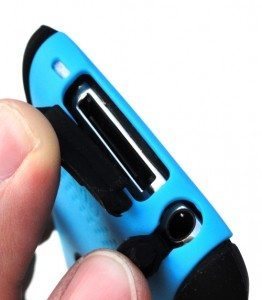 Along the top of the Aegis is a nub integrated into the silicone skin that protrudes through a slot in the plastic shell and protects the iPod touch’s sleep/wake button.
Along the top of the Aegis is a nub integrated into the silicone skin that protrudes through a slot in the plastic shell and protects the iPod touch’s sleep/wake button. 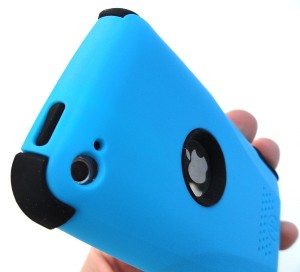 Closeup shot of the bottom rear. Visibile are the heat-dissipating holes, the Trident Case logo and the protective flaps.
Closeup shot of the bottom rear. Visibile are the heat-dissipating holes, the Trident Case logo and the protective flaps. 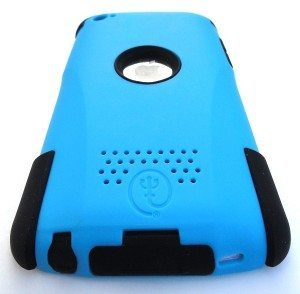 Detail shot depicting one of the silicone corner bumpers and the volume button protector.
Detail shot depicting one of the silicone corner bumpers and the volume button protector. 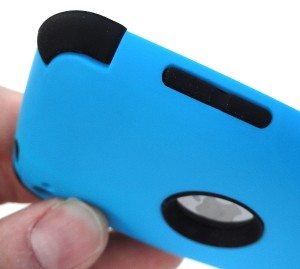 Surprisingly, the silicone skin seems to collect less dust and lint than other, similar cases. Not sure if this is due to surface finish, material, or a combination of the two, but it just seems to collect less.
Surprisingly, the silicone skin seems to collect less dust and lint than other, similar cases. Not sure if this is due to surface finish, material, or a combination of the two, but it just seems to collect less.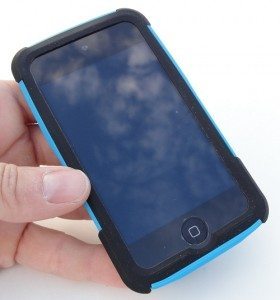 While I realize it is difficult to beat the ultra-thinness of the naked iPod touch itself, the Aegis adds very little thickness for the degree of protection gained.
While I realize it is difficult to beat the ultra-thinness of the naked iPod touch itself, the Aegis adds very little thickness for the degree of protection gained. 
Detail shot depicting the headphone jack port with standard Apple-issue headphone cable inserted, which fit just fine.
Detail shot depicting the audio jack extender. This was included with the Aegis to work around compatibility issues with headphones or audio cables that may be physically too large to fit through the shell and skin. I think its a bit bulky and clunky, and it sticks out so far that it seem to be just begging to be whacked and either sheared off or to damage the iPod touch’s headphone jack. However, as mentioned above, I tried the Aegis with a pair of standard-issue Apple headphones and they worked just fine. I’m not expecting my son to need to use this monstrosity often, if at all, as long as he is using earbuds with a mini plug which are now fairly standard.
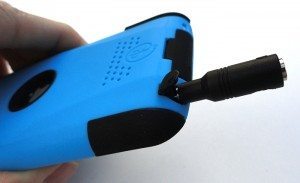
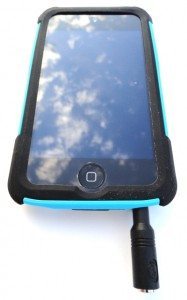 Detail shot depicting the dock connector cable inserted into the access port at bottom. If squared up correctly prior to insertion, it fits nice and snug. Please ignore the bare wire at the cable connector base—my cable has some mileage on it, but it does still work!
Detail shot depicting the dock connector cable inserted into the access port at bottom. If squared up correctly prior to insertion, it fits nice and snug. Please ignore the bare wire at the cable connector base—my cable has some mileage on it, but it does still work! 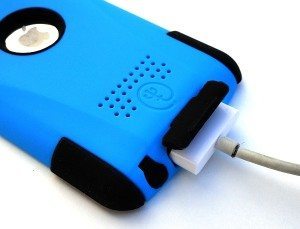 Detail shot of the bottom front, showing the slight cutout enabling full home button access.
Detail shot of the bottom front, showing the slight cutout enabling full home button access.
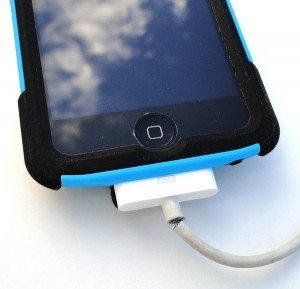 Conclusion
Conclusion
I must confess that I did not expect to like the Aegis as much as I do. There are so many cases out there that I thought this would just be another one. But the styling, quality of materials and construction, attention to details, fit around the device, degree of protection with minimal added bulk—all these things made me a quick believer in the Aegis, if not Trident Cases in general. As for my son, he loves this case. It slides into and out of his pocket—and just plain fits in his pocket—better than his last case. When the day finally comes for me to upgrade to an iPhone 4S (hopefully soon), I’ll be giving Trident Cases serious consideration on my short list of cases for it, and it may give my current favorite—the Speck CandyShell—a run for its money.
Update 03/26/2015
This case dutifully protected my son’s iPod touch until one fateful day when he decided to remove his iPod touch from it for some unknown reason. He promptly cracked the screen and half the display went dead, which was the end of his iPod touch. We had a long talk about why it is important to keep the protective case on your device so that it can actually protect it.
Source: The sample for this review was provided by Trident Case. Please visit their site for more info.
ULAK Compatible with iPod Touch 7/6/5 Case, Clear Transparent Slim Hybrid TPU Bumper/Scratch Resistant Hard PC Back, Corner Shock Absorption Case for iTouch 5th 6th 7th Generation, Clear
$7.99 (as of December 2, 2025 19:41 GMT -05:00 - More infoProduct prices and availability are accurate as of the date/time indicated and are subject to change. Any price and availability information displayed on [relevant Amazon Site(s), as applicable] at the time of purchase will apply to the purchase of this product.)ULAK Compatible with iPod Touch 7/6/5 Case with 2 HD Screen Protectors, Hybrid Rugged Shockproof Cover with Built-in Kickstand for iPod Touch 7th/6th/5th Generation (Red)
$8.89 (as of December 2, 2025 19:47 GMT -05:00 - More infoProduct prices and availability are accurate as of the date/time indicated and are subject to change. Any price and availability information displayed on [relevant Amazon Site(s), as applicable] at the time of purchase will apply to the purchase of this product.)Product Information
| Price: | $29.95 |
| Manufacturer: | Trident Case |
| Requirements: |
|
| Pros: |
|
| Cons: |
|

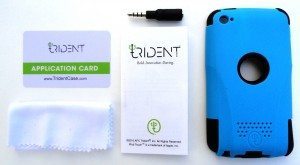
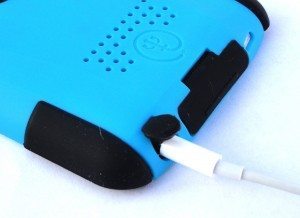


Gadgeteer Comment Policy - Please read before commenting
I have one of these trident cases for my nook color and it was worth every penny. My nook took a spill on a tile (yes, tile) floor at high velocity and survived without a scratch or blip. The hard shell of the case actually cracked at its thinnest point (where it surrounded the headphone jack, but I’ll take that any day over buying a new device.
The blue is what I have, and it looks as good in real life as it does in the photos.
@Lucy – Thanks for sharing this feedback! So is it the Aegis for Nook case you have, and in the same blue color?
I have the Aegis for the Nook, Andy, and in the same blue color. It keeps it from getting lost in the black cave of my bag.
I want to add though that the case adds a little girth, and definitely some weight to the nook, but obviously that extra padding serves a purpose. I was going to get just a regular silicone sleeve but I’m really glad I didn’t. You can feel the better quality of the aegis.
@Lucy – I agree that the Aegis does add some girth and weight, even to the iPod touch. I also agree that, as you said, the extra padding serves its purpose. They’ve designed the Aegis case series quite well.
Does the case interfere at all with the flash or cause reflections off the case when taking pictures? I know that this has been a complaint against a number of iPhone cases with really tight camera/flash cutouts. That’s why many manufacturers have switched to bigger cutouts that surround the camera and the flash.
@Brett – I can’t answer your question in this situation, because the Aegis case I reviewed above was for the iPod touch 4th gen, which does not have a flash.
However, I just (this past Saturday) bought an iPhone 4S and Speck Candyshell case for it. The Speck Candyshell has quite a large opening on the back for the camera and flash, so much so that I wondered to myself why it is so big. Your last statement gives me a clue why this might be.
Thanks. I ended up buying a PixelSkin HD for my iPhone 4 and plan on getting an Otterbox Defender for my wife’s forthcoming iPhone 4S since it will spend much of its time bopping around in her bag.
Thanks for the sharing – I haven’t seen anything mentioned whether it works in ipod Doc’s…..I am sure there is some variance in docks but if the bulk does interfere that is a selling point – maybe none work for that matter….Son is looking to get an IPOD touch 4th generation and researching cases
@Warren – You will have difficulty in getting the Aegis case to work with a dock. The reason is mainly due to the silicone flap that protects the docking port. Even if you open it and pull it back out of the way, there is too much bulk there for most docks. I suppose you could take an Exacto knife and carefully remove the silicone flap (do this at your own risk), but this would defeat the flap’s purpose of protection of the dock connector port.
Another solution might be to use one of the many dock extenders that are available, such as this one:
http://the-gadgeteer.com/2011/07/12/dock-cable-extender-for-the-iphone-and-ipod-touch/
For the Aegis on my son’s iPod touch 4g (depicted in the review above), we just plug in the Apple charge cable.
Okay, so I bought one of these the other day from Amazon for 18$.. It’s perfect! Great product!!! Only problem I have is the headphone jack flap, very hard to open..bi can’t get it open! Help? Did I put the hard shell on wrong?
@Alex – It is possible that the headphone jack flap is caught under the hard shell. I recall having to carefully guide the flap through its hole in the hard shell as was installing it. For me, the headphone jack flap worked fine once I had the hard case installed.
Yes, that’s the problem I have, I’m wondering if there’s any way I could fix it?
@Alex – Other than what I’ve described in my comment above, I’m not sure what else to suggest. Anyone else have an issue like this and can offer advice?